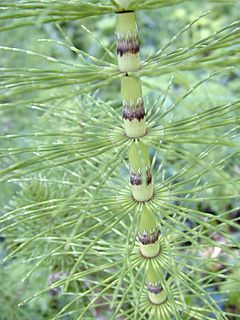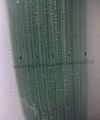Horsetail facts for kids
Quick facts for kids Equisetum |
|
|---|---|
 |
|
| Vegetative stem of Equisetum telmateia with a whorl (at each node) of branches and dark-tipped leaves | |
| Scientific classification | |
| Kingdom: | |
| Division: | |
| Class: |
Equisetopsida
|
| Order: |
Equisetales
|
| Family: |
Equisetaceae
|
| Genus: |
Equisetum
|
Horsetails are a special group of ferns. They were once very important plants on Earth. Long ago, during the Paleozoic era, some horsetails grew as tall as 30-meter trees! You can still find their remains in Carboniferous coal beds. Today, most of these ancient plants are extinct. But one genus called Equisetum still survives. Horsetails are vascular plants, meaning they have special tissues to carry water and nutrients. They reproduce using tiny spores, not seeds. The name "horsetail" comes from how some branched species look a bit like a horse's tail.
Meet Equisetum: The Living Horsetails

Equisetum is the only type of horsetail still alive today. Its name comes from two Latin words: equus, meaning "horse," and seta, meaning "bristle." There are about 15 different species of Equisetum.
These plants grow naturally on almost every continent. You can find them everywhere except Australasia (like Australia) and Antarctica. Most horsetails are perennial plants. This means they live for more than two years. Many species in cooler places are herbaceous; they die back in winter and regrow in spring. But some tropical kinds, and a few temperate ones, stay green all year round.
Most Equisetum plants grow to be about 0.2 to 1.5 meters tall. However, some can get much bigger! For example, E. telmateia can reach 2.5 meters. The tropical American species E. giganteum can grow up to 5 meters. And E. myriochaetum can even reach an amazing 8 meters tall!
How Horsetails Look
Horsetails have very small leaves. These leaves grow in whorls, which are circles around the stem. They join together to form a sheath around the stem. The stems themselves are green and can make their own food through photosynthesis. They are also special because they are hollow, jointed, and have ridges. Usually, they have between 6 and 40 ridges.
Sometimes, you'll see branches growing in whorls at the stem's joints. These branches look just like smaller versions of the main stem.
There's another plant called Hippuris, also known as "mare's tail." It looks a bit like a horsetail but is actually a flowering plant and not related to Equisetum at all.
Images for kids
-
Equisetum arvense (field horsetail)
-
Microscopic view of Equisetum hyemale (rough horsetail) (2-1-0-1-2 is one millimetre with 1⁄20th graduation). The small white protuberances are accumulated silicates on cells.
-
Equisetum hyemale (rough horsetail) in Parc floral de Paris
-
Equisetum × moorei (E. hyemale × E. ramosissiumum)
See also
 In Spanish: Cola de caballo para niños
In Spanish: Cola de caballo para niños







